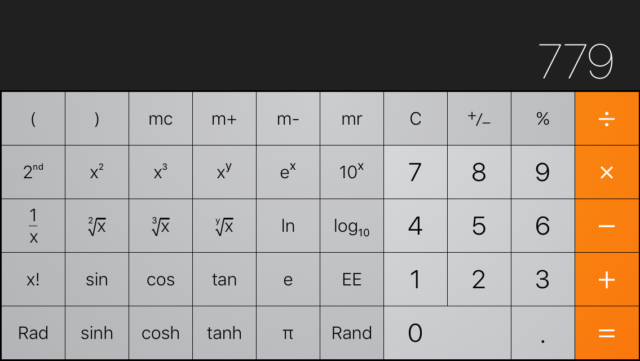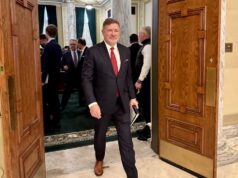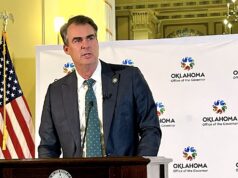(Editor’s note: The Yes on SQ 779 campaign is advertising on NonDoc. This commentary was submitted by the author without that campaign’s knowledge or influence.)
When Oklahomans go to the polls in November, they will vote on whether to amend the state constitution to create a new fund to improve public education. A new one-cent sales-and-use tax would finance it. This measure is known formally as State Question 779.
Not all Oklahomans favor this measure — municipal-employee organizations, including some police and fire unions, worry that an increased state sales tax will make it more difficult to levy local sales taxes that fund their employment — but a record 300,000+ of us signed the initiative petition that placed the measure on the ballot. I will be voting yes.
On the ballot we will see the following text:
“This measure adds a new Article to the Oklahoma Constitution. The new Article creates a limited purpose fund to improve public education. It levies a one cent sales and use tax to provide revenue for the fund. It allocates funds for specific institutions and purposes related to the improvement of public education, such as increasing teacher salaries, addressing teacher shortages, programs to improve reading in early grades, to increase high school graduation rates, college and career readiness, and college affordability, improving higher education and career and technology education, and increasing access to voluntary early learning opportunities for low-income and at-risk children.
It requires an annual audit of school districts’ use of monies from the fund. It prohibits school districts’ use of these funds for administrative salaries. It provides for an increase in teacher salaries. It requires that monies from the fund not supplant or replace other education funding. The Article takes effects on the July 1 after its passage. Shall the proposal be approved?”
Note that the ballot title contains no numbers, unlike the full text of the measure, which is explicit about how the money is to be allocated to 1/100th of a percent.
Constitutional provisions that specify numbers to 1/100th of 1 percent arouse my arithmetical curiosity. I’m going to look in detail at what the arithmetic means in terms of dollars raised and spent.
The amount to be raised
First, let’s look at the amount of money to be raised. Current Oklahoma state sales (and use) tax is 4.5 percent. An additional penny makes that 5.5 percent. Going from 4.5 to 5.5 is a 22 percent increase, so this new levy is going to increase state collections by 22 percent. (Oklahoma cities and towns charge various sales tax rates themselves in addition.)
SQ 779 advocates have stated that the new levy will generate about $615 million. Roughly speaking, $615 million is 22 percent of $2.8 billion. Since state sales tax collections for the 12 months ending June 30, 2015 (fiscal year 2015), were $2,688,594,291.59, and collections for the 12 months ending June 30, 2016, were likely less, $615 million may be a bit ambitious. So let’s go with the fiscal year 2015 figure, rounded up to $2.7 billion. That’s the tax collection, and 22 percent of $2.7 billion is $594 million, or almost $600 million.
(That can serve as a rough estimate of the new revenue for this exercise, though the Oklahoma Retail Protection Act of 2016 takes effect Nov. 1, which will seek to collect sales and use tax on online and other retailers beginning in 2017.)
School district allocations, teacher raises
Article 3.A.1 of the constitutional amendment would require that 69.5 percent of the revenue from the new levy go to school districts, and section (b) of that article further requires that 86.33 percent of that 69.5 percent be used to “increase teacher salaries as required by Section 4 of this article”; Section 4 requires a salary “at least $5,000 greater” than the salary schedule the district used before the amendment was adopted. So the districts will have 69.5 percent of the $600 million new revenue, or $417 million. Of this, they are to use 86.33 percent ($361 million) to carry out the provisions of Article 3.A.1.(b).
Oklahoma has about 42,000 (full-time equivalent) teachers, according to the National Center for Educational Statistics. Giving each one a $5,000 raise (as per Section 4 of the amendment) will cost $210 million. So that leaves about $151 million ($361 million minus $210 million) unspecified.
Article 3.A.1.(b) says something about what to do with the balance, which we will get to in a moment, but first let’s look at something it does not say. Oklahoma school districts make a contribution to the Oklahoma Teacher’s Retirement System at a rate of 9 percent of each employee’s salary. (The employee also contributes 8 percent.) The district also contributes a percentage to Social Security (6.2 percent) and Medicare (1.45 percent) for each employee. (The employee contributes the same percentages.) Thus, the district contributes 16.65 percent of the employee’s salary.
If the salary is increased by $5,000, the district contributes $832.50 more to Social Security, Medicare and Teacher’s Retirement. For 42,000 teachers, this amounts to nearly $35 million dollars. Surely the SQ 779 authors did not intend to put an additional burden like this on the districts, so they presumably expect that money to come out of the unspecified $151 million previously noted. So the actual unspecified balance is $116 million ($151 million minus $35 million). Let’s note also that the combined cost of the $5,000 raises plus the districts’ share of Social Security and teacher’s retirement is $245 million.
| MATH NERD’S GUIDE TO SQ 779 | |
| CURRENT SALES TAX | 4.5% |
| PROPOSED TAX UNDER SQ 779 | 5.5% |
| OVERALL TAX INCREASE | 22.0% |
| ADVOCATES’ REVENUE ESTIMATE | $615M |
| FY 2015 SALES TAX COLLECTIONS | $2.7B |
| MATH NERD’S REVENUE ESTIMATE | $600M |
| ARTICLE 3.A.1 | |
| 69.5% to SCHOOL DISTRICTS | $417M |
| 86.33% of DISTRICT ALLOCATION to SALARY INCREASES | $361M |
| -TEACHERS in OKLAHOMA | 42,000 |
| -COST of $5,000 RAISES for EACH | $210M |
| -COST of CONTRIBUTIONS to RETIREMENT FUNDS | $35M |
| 13.67% of DISTRICT ALLOCATION to EARLY ED, GRAD. RATES, COLLEGE PREP | $57M |
| REMAINING FUNDS from DISTRICT ALLOCATION | $116M |
| REMAINING REVENUE OVERALL (30.5% of ANNUAL SALES TAX REVENUE) | $183M |
| ARTICLE 3.A.2 | |
| 19.25% to HIGHER EDUCATION | $115M |
| ARTICLE 3.A.3 | |
| 3.25% to CAREER/TECHNOLOGY TRAINING | $19M |
| ARTICLE 3.A.4 | |
| 8% to EARLY CHILDHOOD EDUCATION | $48M |
Article 3.A.1.(b) goes on to say that after they have made the $5,000 per teacher raise, districts can use the money to “otherwise address and prevent teacher and certified instructional staff shortages in the manner most suited to local district circumstances and needs, including but not limited to differentiated compensation methods or performance pay.”
Performance pay, sometimes called merit pay, for teachers has been a controversial topic in Oklahoma. The opposition has not been from teachers who think their performance would not merit a raise; it is from those who believe that spending on merit is counterproductive until Oklahoma salaries match regional averages.
Merit pay is, however, common in Oklahoma higher education, where salaries also lag national averages. Differentiated compensation is also common in higher education (law professors are paid more than English professors), and, in public schools, differentiated compensation might amount to paying math and science teachers on a higher scale.
So let’s assume that a quarter or so of Oklahoma teachers deserve some performance pay, and an additional quarter or so deserve some differentiated compensation. Some will deserve both, of course. For the sake of argument, let’s assume that the total is a little less than half, or 20,000 teachers. In order that the district contribution of 16.65 percent be included in the $116 million, we first divide by 1.1665, so that there is $99 million to distribute for performance pay and differentiated compensation to 20,000 teachers. This amounts to an average $4,950 per teacher, which, when added to the $5,000 base increase, should make it possible to address the shortages to which Article 3.A.1.(b) refers. Of course, $4,950 is only an average; the district’s share of the $99 million may well make some five-figure merit raises possible.
Article 3.A.1 goes on to specify how the rest of the money is to be spent. Of the 69.5 percent of the new revenue ($417 million) that would go to the districts, Article 3.A.1(c) specifies that 13.67 percent ($57 million) must be spent on improving reading in the early grades, improving high school graduation rates and increasing college and career readiness.
Other allocations
As noted above, Article 3.A.1 requires that 69.5 percent of the new revenue (which I estimated at $600 million) goes to common education. That leaves 30.5 percent of the new revenue ($183 million) to be spent elsewhere. The amendment specifies that 19.25 percent of the new revenue ($115 million) would go to higher education (Article 3.A.2); that 3.25 percent ($19 million) would go to career and technology education (Article 3.A.3); and that 8 percent ($48 million) would go to early childhood education (Article 3.A.4).
Some may observe that $245 million is 8.75 percent of $2.7 billion (recall that the latter is our estimate of annual state sales and use tax collection before the increase), so if the state sales and use tax were increased from 4.5 percent to 4.89375 percent (an 8.75 percent increase in the tax rate), an increase of $0.003975 instead of $0.01, that would pay for (and only for) $5,000 raises for 42,000 teachers. Others may observe that $600 million new revenue, from the proposed $0.01 increase in SQ 779, would pay for (and only for) raises of $12,264.65 (covering districts’ retirement costs) for 42,000 teachers.
Vote ‘yes’ on SQ 779
I was taught basic math, like arithmetic and percentages, in Oklahoma public schools. That I learned what I was taught was due in no small measure to the teachers who taught me.
I applaud measures like SQ 779 that aim to pay Oklahoma teachers what they deserve. A raise of $5,000 is a nice round number, which makes Oklahoma’s teacher salaries comparable on average. A cost of one penny is also a good round number. As noted above, the raises cost $245 million; the penny generates at least $600 million. We saw that, of the balance, $116 million is going to merit pay and differential compensation for teachers, and $115 million to higher education.
Both, in my opinion, are worthy ways to spend money on education. I intend to vote “yes” on SQ 779. You should, too.






















